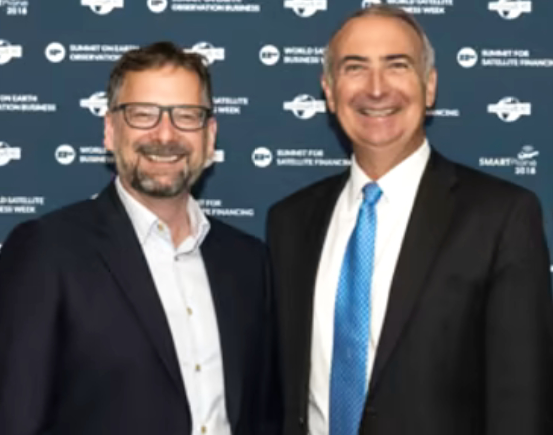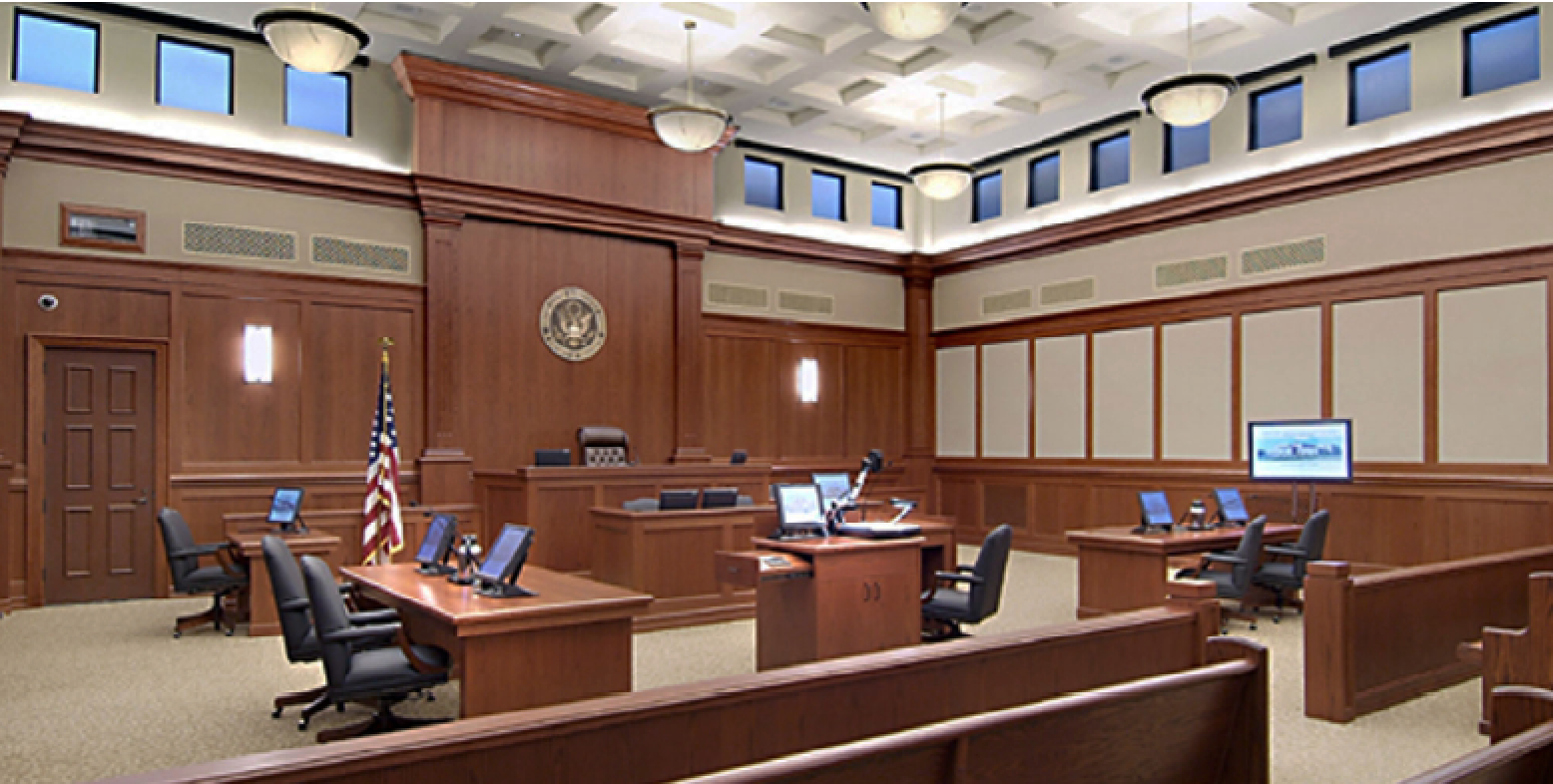On February 23, 2022, Judge Keith Phillips ruled that SES should defer its deposition of Mr. James Murray, an expert witness called by Intelsat to help minimize the impact of any damages against Intelsat (“a discount rate analysis”). Judge Phillips said that, should the Court determine that SES has a claim against Intelsat, then Murray can be deposed and SES could then call their own expert witness. The decision could well be one of the last acts ahead of the Court’s decision as to whether a 50/50 split of the FCC’s C-band incentive payments should be ordered in SES’s favor.

Steve Collar (l) and Steve Spengler (r).
SatMagazine makes no apology for this extensive report on the satellite ‘trial of the century’ and which reflects day after day of monitoring and transcription of the Zoom proceedings. SES is seeking a 50% share of the FCC’s incentive payments, as well as claiming breach of contract, unjust enrichment and breach of fiduciary duties. The 50-50 split, if agreed by the Court, would put some $421 million into SES’s pocket, plus expose Intelsat to claims of punitive damages.
That 50/50 cash division — and potential damages against Intelsat — is now up to Judge Phillips to decide and it has to be stated that there were plenty of 50-50 elements in place. For the judge to ignore the highly relevant direct evidence of Intelsat’s former VP/Investor Relations (and subsequently head of corporate/marketing communications) Dianne VanBeber — that might be difficult. She has been described in Court documents as a ‘whistleblower’ and, like many who, have taken a similar view of their former employer, her statements to the Court were compelling.
VanBeber gave her evidence to the Court on February 10 and said she had worked at Intelsat since 2001, other than an 8 month period in 2005. Questioned in detail on her experience during the establishment of the C-Band Alliance (CBA), she told the Court that she was appointed the lead communicator on that project. She explained that she had worked with Steve Spengler for years, initially when they both worked together at Spacenet where he was “a sales guy.”
When they were working at Intelsat, they spoke together almost daily and she felt they each had a lot of trust in one another. Ms. VanBeber left Intelsat on March 2, 2020, leaving voluntarily after what she said was a “gut wrenching” period at the CBA. She told the Court that Intelsat had changed its direction and what she was being asked to communicate [to the press] was “certainly not what I had been told by executives.” She told the Court that, to her mind, it was a shift in the way the company was behaving and operating.
She told the Court that the close cooperation between Intelsat and SES was “unprecedented” and that the agreement between the two, within the CBA, was that whatever both companies received [from the sell-off of spectrum] would be combined and split “roughly 50-50 between received [from the s the two companies.”
However, she said that decision was subject to a complete shift when Intelsat severed its relationship with SES and left the CBA in February of 2020. She explained that the CBA had initially worked for a “market-based approach” to the sell-off of spectrum, but the FCC decided to hold its own auction.
At one point, she said Michelle Bryan (Intelsat’s General Counsel) told VanBeber to take down the CBA web-site, LinkedIn pages and Twitter feed, although this represented an “abrupt change,” even though — at almost the same time — Intelsat was facing the problems of bankruptcy which was “knocking on the door.”
Questioned as to why the change had been made, VanBeber said she was told that Intelsat could no longer abide with the contract it had gone into with SES.
VanBeber said the pressures on Intelsat were considerable. There was an upcoming debt maturity due in May or June of 2020 that was going to be an issue because the company was not going to be able to refinance it. The debt interest, she said, was about 7.75%, and Intelsat was unlikely to be able to refinance at that rate, “if at all.”
Simultaneously, there were on-going discussions with the FCC with Intelsat’s [then] CFO David Tolley having meetings in an attempt to try and obtain for Intelsat a high payment [from the FCC]. She said that the FCC was “kind of dividing and conquering us” and this meant Intelsat was going to have to deal with the FCC— solo.

She told the Court that the CBA and its negotiations were “right” and that the period working with SES — once described internally at Intelsat as “the evil Empire” — resulted in a highly effective team. “We gelled as a team... we were really linked arm in arm.”
In early February of 2020 Intelsat, moved from publicly talking about the 50-50 division of revenues to telling VanBeber to change the narrative. She left Intelsat on March 2 and said that she felt the wheels were then coming off the bus. In two — probably intensive — weeks, she had to attempt to manage a message that changed from a 50-50 agreement with SES to one where Intelsat was dealing on its own with the FCC.
Her comments to the Court were telling, and she stated that her integrity was important as was her credibility with investors. She said she did not want to be in a position where her credibility was eroded.
“I was uncomfortable,” she told the Court, adding that the timing of Intelsat’s decision was wrong in her view and that the company should have made the decision [to quit its 50-50 agreement] sooner than February 7 of 2020.
She explained why she felt the way she did, and praised SES for coming into the CBA “from the beginning” and that Intelsat could not have achieved anything without SES. “There wouldn’t even have been a shot [at the project].” She added that Intelsat was treating a partner — who had acted in good faith — incorrectly.
Questioned regarding Steve Collar [SES CEO] and his involvement in the final hours of the CBA, and what had occurred when Steve Spengler [Intelsat’s CEO] had telephoned Collar at 3:00 a.m. on February 7 and what she knew about the call. VanBeber said the conversation was difficult and that her impression was that the call was one that CEOs had to make, even though they may not have emotionally agreed with the decision that they would have to take. She stressed that she knew Spengler as someone with a high degree of integrity and one who had formed a close relationship with Collar.
The Court was shown an email exchange dated January 14-15, 2020, between VanBeber and Bruno Fromont [CTO, Intelsat and a “lead” executive on the C-band project] and which talked about the FCC moving ahead and running its own auction. In this email, she was asking Fromont to confirm the form of words she suggested. Crucially, the email continued to talk about the 50-50 agreement “irrespective of the final [ultimate value] count…because of the binding agreement between SES and Intelsat.” Her message to investors continued to communicate the “roughly” 50-50 division.
VanBeber said it was vital that any communications to the outside financial community had to be accurate and she wanted to be in lockstep with SES [and in particular Richard Whiting, SES’s head of investor relations]. She said that the duo continued to believe it to be better that SES and Intelsat were unified in their dealings with the FCC. She added that the CBA continued — following the FCC decision — to mount its own auction. The CBA continued to have joint customer presentations, discuss new satellites as well as lobbying Capitol Hill.

The Court was shown a Consortium Agreement dated September 27, 2018, and circulated to senior staff at Intelsat, and with Ms. Bryan and a former Intelsat lawyer Sue Crandall now seconded to the CBA and stating that Intelsat must project itself as a Delaware-registered and US company, even though it was a challenge as neither of the Intelsat businesses were ultimately domiciled in the US and thus not subject to US taxation. [Luxembourg-based] Intelsat SA, she said, had only two employees and that everyone at the Intelsat HQ in the US worked for Intelsat US LLC.
Cross-examined by Intelsat’s lawyers, VanBeber confirmed that she had not drafted the Consortium Agreement but was heavily involved in drawing up the joint press release from Intelsat, SES, Telesat and Eutelsat of October 1, 2018, which followed the establishment of the CBA.
VanBeber denied that she had — after her departure — contacted SES and offered any sort of ‘whistleblower’ testimony. She said that SES had reached out to her in December of 2020 and knew how saddened she was when the Consortium Agreement was abandoned. Her deposition to SES was made voluntarily, and without compensation. Moreover, her testimony was truthful, even though she was uncomfortable that her evidence could have testimony was truthful, even though she was uncomf ramifications for Intelsat and at a personal cost to her.
Intelsat CEO Steve Spengler was also questioned on February 23 and told the Court that the company was suffering declining revenues and had proposed its [code word] Copernicus project, which eventually morphed into a plan to convert some of the company’s C-band assets. Spengler said that Intelsat’s internal financial documents showed it would run out of cash sooner than 2022. Hence, one option was to sell — and receive — “substantial” C-band proceeds.
Spengler said that selling off C-band would be a potential “game changer” for Intelsat. However, to maximize that revenue, it was important to cooperate with its transmission rivals in a partnership.
Spengler reached out to Karim Sabbagh, then the CEO at SES. Spengler told the court that from the earliest conversations, it was clear that SES wanted a 50-50 split of proceeds. Spengler said that Sabbagh and he had agreed that a 50-50 split was the working hypothesis, and that a contract was signed that contained reference to a 50-50 split. Spengler told the court that Intelsat needed SES’s cooperation more than SES needed that of Intelsat.
Steve Collar (CEO at SES) succeeded Sabbagh in April of 2018 and he told the Court he quickly developed a “personal relationship” and “liked” Collar. A conversation between the two CEO’s in the spring of 2018 saw Collar stress that the 50-50 split was “incredibly important” to SES and that any further agreement could not be signed without the 50-50 position being in place.
However, one point under discussion was that SES might give Intelsat a “finders fee,” which Collar confirmed in an email dated May 5, 2018. In September of 2018, the Consortium Agreement was executed, initially with Eutelsat and Telesat also included. The Agreement allowed for legal fees and expenses to be paid, as well as such elements due to Eutelsat and Telesat, and then all subsequent cash would be divided 50-50.

U.S. Intelsat Headquarters
Spengler explained to the Court the problems and build up which led to the FCC’s decision to hold its own spectrum auction, and this included the ‘DEFCON’ possibility that the US government would retain all the proceeds of the auction.
Spengler said that he had never challenged the 50-50 agreement with Collar.
It also emerged that, at one point, Intelsat suspected that the FCC’s payment to them would be just $2.55 billion, and that amount was “much too low” (stated Spengler) and not adequate enough to meet Intelsat’s debt issues.
Time and again during Spengler’s evidence, and with the Court being shown emails from senior Intelsat staff involved in the CBA, it was assumed in writing that the 50-50 agreement would prevail. During early February of 2020, Collar was in Washington DC and met Spengler almost every day and worked out of the Intelsat office as SES. Intelsat argued for a sum larger than the overall $5 billion being offered by the FCC. Collar, with other SES and Intelsat execs, visited the White House as part of their lobbying.
Almost at that same time, there were frequent Board meetings at Intelsat (four in one week, for example), but Spengler said the 50-50 agreement was not discussed during these Board meetings, other than at one point when Spengler told the Board that the 50-50 deal still held.
The Court heard that at the February 4 meeting with (then) FCC Chairman Ajit Pai, the consortium visitors to the FCC were told that the deal would be to “take it or leave it” and, if there were grumbles, then the payment would be reduced to $5 billion.
But then, evidently prior to a planned breakfast meeting between Spengler and Collar and ahead of the Chairman Pai meeting, Michelle Bryan (Intelsat VP/General Counsel) stated in an email that a deal had been reached with Telesat whereby it would receive not less than 3% [of the FCC proceeds], and that SES and Intelsat could split 50-50 the balance. Ms. Bryan’s email went on to say that, following a Board meeting the previous evening, Intelsat was not prepared to sign this new agreement.
Spengler said that in the following days, he and Collar collaborated and worked closely in boosting the payment due from the FCC from a possible $5 billion to the much more attractive $9.7 billion, and was the only time in history that such a deal had been struck. Further discussions with the FCC also pushed for an overall $11.5 billion in incentive payments.
The Court heard that a further meeting between Spengler and Collar on February 6 where, again, Collar stated that SES still wanted the 50-50 deal maintained. His comments were not countered by Spengler, suggesting that the deal was off.
An exchange of emails between Michelle Bryan and David Tolley (Intelsat’s CFO) and where Mr. Tolley said that (SES’s) Christophe De Hauwer had met, and that Tolley had “feigned complete surprise” as to what was being said [and despite knowing what had already been decided by the Intelsat Board]. On February 4, Tolley emailed Bryan saying that De Hauwer had stressed that if Intelsat didn’t agree to the 50-50 agreement, then the entire FCC deal was off.
Meanwhile, a telephone call with Spengler and Collar and the FCC had discovered that the FCC would only go to $9.7 billion as incentive payments. The Court was told that Collar had a list of topics and “talking points” for discussion with the FCC, one of which was a request to the FCC to raise their offering by 10%.
Spengler said he didn’t remember that aspect of the discussion, although he confirmed to the Court that the FCC’s Nicholas Degani [then senior counsel to Ajit Pai] had discussed the SES and Intelsat 50-50 split. After the call Spengler and Collar went for “celebratory drinks” and Spengler confirmed that he did not say the 50-50 deal was off.
The celebration on the evening of February 4 at Eddie V’s restaurant at Tyson’s Corner, a few meters from Intelsat’s HQ, was in respect of the FCC moving from $5 billion, to $8.8 billion and then to the $9.7 billion just discussed.
The following morning Collar, texted Spengler (at 3:00 a.m. EST ) saying that Spengler had done a good thing and that SES were partners in the project “to the end.” Spengler responded and stated it had been a long journey.
However, it was on the morning of February 6 that the FCC announced that it would issue a draft order confirming the $9.7 billion position on February 7. This prompted Intelsat’s CFO David Tolley to contact the FCC because the division of cash suggested by the draft order was for 50-50 and Intelsat wanted its share to be 58% of the total. Without 58% then Intelsat “would be forced to litigate” and could not support the proposal.
The Intelsat Board was told that FCC had called and had misunderstood the request from Intelsat and SES despite Mr. Degani having asked Spengler whether he agreed with the 50- 50. Spengler told the Court that the gap between Intelsat and SES “would be narrowed” [from the 58% now on the table].
Spengler telephoned Collar at 3:00 a.m., DC-time, who was now back in Europe and told the Court that this was a very difficult call. At that point, the FCC’s Draft Order had not been released publicly. Spengler said he told Collar that the Intelsat Board’s lowest expectation was to receive $5.6 billion.
CFO Tolley at this time sent a series of emails with proposals to bring Dan Goldberg, CEO at Telesat, into the dialog to try and calm Collar who was — the Court was told — “screaming” about the now broken 50-50 deal.
Spengler spoke to Goldberg and told him that Intelsat would now deal independently with the FCC. Goldberg, in evidence, said that [such a move] would be bad and not a good precedent for Intelsat.
Mr. Spengler said the breaking of the 50-50 contract was an option of “last resort” and that the agreement had been “frustrated... and not breached.”
Later, in rebuttal questioning from his lawyers, Mr. Spengler confirmed the 50-50 agreement was very important to SES. But he said that the 50-50 was specifically related to the C-Band Alliance and its “market-based approach.” He agreed that the 50-50 was “essential” to achieving what was a very challenging and bold project and proposal.
That’s the basis of the trial in front of Judge Phillips. At some point over the next months, the Judge will decide and rule. First, there has to be “findings of fact and conclusions of law” hearing. Of course, should the decision go against Intelsat, then there’s likely to be an appeal, so this process is far from over.

Author Chris Forrester is a well-known broadcasting journalist, industry consultant and Senior Columnist for SatNews Publishers. He reports on all aspects of broadcasting with special emphasis on content, the business of television and emerging applications. He founded Rapid TV News and has edited Interspace and its successor Inside Satellite TV since 1996. He also files for Advanced-Television.com. In November of 1998, Chris was appointed an Associate (professor) of the prestigious Adham Center for Television Journalism, part of the American University in Cairo (AUC), in recognition of his extensive coverage of the Arab media market.


